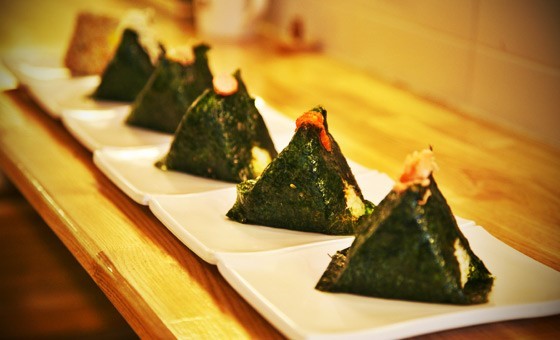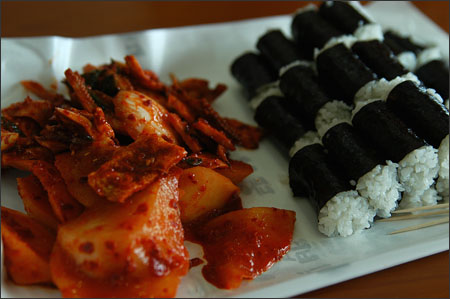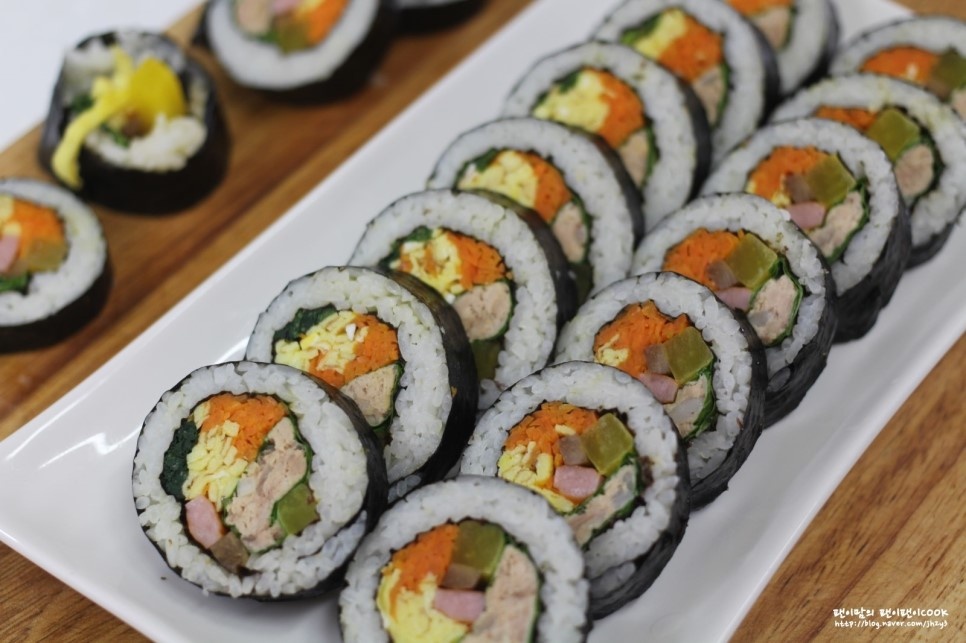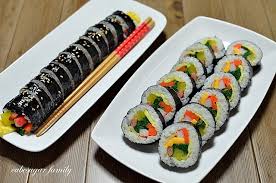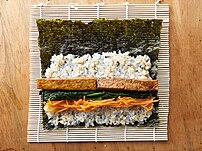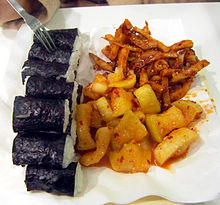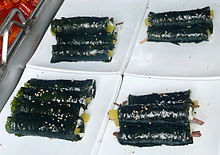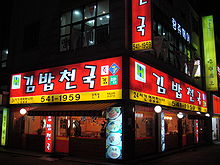Кимпаб (кор. 김밥) — популярное блюдо (закуска) корейской кухни, представляет собой роллы, завернутые в сушеные прессованные листы «морской капусты» (김 ким), наполненные приготовленным на пару рисом (밥 пап), с добавлением начинки, нарезанной или выложенной полосками, обычно квашеных овощей, рыбы, морепродуктов, ветчины и омлета. К столу кимпаб подают нарезанным кружочками, которые едят, взяв палочками и обмакнув в соевый соус с семенами кунжута.
Кимпаб произошёл от японских роллов «футомаки», блюдо было заимствовано во время японской оккупации. Суши кимпаб отличаются тем, что рис почти не содержит уксуса, также в кимпаб не кладут сырую рыбу. Обычно кимпаб употребляют на пикниках и вообще на улице, а также в качестве закуски, в этом случае кимпаб подают с такуаном или кимчи.
Виды Кимпаба
Самгак кимпаб (кор. 삼각김밥) — треугольные кимпаб, которые продаются во многих универмагах Южной Кореи. Самгак кимпаб также имеет много разновидностей.
Чунму кимпаб (кор. 충무김밥) — кимпаб с одним только рисом. Произошёл из города Чхунму. Чунму кимпаб тонкие и не поливаются маслом. Его обычно подают с ккольттуги мучим (кор. 꼴뚜기 무침), маринованными и квашенными в острой жидкости с красным перцем маленькими осьминогами, а также му-кимчи (кор. 무김치, кимчи из дайкона).
Чамчи кимпаб (кор. 참치김밥) — ещё один популярный вид кимпаба; его заправляют тунцом, маринованными листьями кунжута, майонезом или сыром и другими ингредиентами.
Основные ингредиенты : (для 2 порций) 4 чашки риса, 5 стаканов воды, 4 листа готового кима, 5 яиц, 100 г фарша говядины, 50 г моркови, 1/2 огурца, 120 г маринованной редиски, 80 г шпината, растительного масла
Ингредиенты для приготовления риса: 1 штука 5х5 см бурых водорослей, 1/2 ст.л. рисового вина, 1 ч.л. оливкового масла (можно кунжутного)
Приправы для готового риса: 1 ст.л кунжутного масла, 10 г соли, 10 г кунжута
Приправы для фарша говядины: 1 ч.л. измельченного чеснока, 1 ст.л. соевого соуса, 1 ч.л. сахара, щепотка молотого перца
Промыть рис 4-5 раз.
Добавьте 5 чашек воды с листом водоросли 5х5 см.
Взбейте яйца, добавьте туда щепотку соли.
Обжарьте омлет как блин , подождите пока остынет, затем разрезать на полоски шириной 0,5 см.Нарежьте морковь также и обжарьте в хорошо нагретой масляной кастрюле (сковороде) минутки 2.
Продержите шпинат в кипящей воде ( в воду добавить 1 ч.л. соли) держать примерно 30 секунд, затем остудить в холодной воде и выжать воду.
Готово ! Приятного аппетита !
☑ Добавление кусочка бурых водорослей к рису во время его приготовления не только обогатит вкус, но и сделает его идеальным для кимпаба.
☑ При использовании риса, произведенного в зарубежных странах, добавьте рисовое вино и оливковое масло за 5 минут до готовности, чтобы придать ему блеск. Это также поможет предотвратить прилипанию риса на руки при готовке.
From Wikipedia, the free encyclopedia
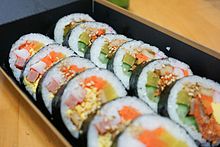
Sliced vegetable gimbap |
|
| Place of origin | Korea |
|---|---|
| Main ingredients | Gim, bap |
| Variations | Chungmu-gimbap, samgak-gimbap |
|
| Korean name | |
| Hangul |
김밥 |
|---|---|
| Revised Romanization | gimbap |
| McCune–Reischauer | kimbap |
| IPA | [kim.bap̚]~[kim.p͈ap̚] |
Gimbap (김밥), also romanized as kimbap, is a Korean dish made from cooked rice and ingredients such as vegetables, fish, and meats that are rolled in gim (김)—dried sheets of seaweed—and served in bite-sized slices.[1] The origins of gimbap are debated. Some sources suggest it originates from Japanese norimaki, introduced during Japanese colonial rule,[2][3][4][5] while others[who?] argue it is a modernized version of bokssam from the Joseon era. Regardless, it has since become a distinct dish.[6] The dish is often part of a packed meal, or dosirak, to be eaten at picnics and outdoor events, and can serve as a light lunch along with danmuji (yellow pickled radish) and kimchi. It is a popular take-out food in South Korea and abroad[7] and is known as a convenient food because of its portability.
Etymology[edit]
Gim (김) refers to edible seaweed in the genus Porphyra and Pyropia. Bap (밥) broadly refers to cooked rice. The compound term gimbap is a neologism; it was not a part of the Korean language until the modern era.[when?] A similar dish, cooked rice rolled with gim, was called bokssam (복쌈; 福-) in the Joseon era (1392–1897).[8][9]
The term gimbap was used in a 1935 Korean newspaper article[10] but at the time, the loanword norimaki was used as well. Norimaki, borrowed from the name of a similar Japanese dish, was part of the Japanese vocabulary that entered into the Korean language during Japanese occupation (1910–1945). The two words were used interchangeably until gimbap was made the universal term, as part of efforts to clear away remnants of Japanese colonialism and purify the Korean language.[11]
History[edit]
The origins of gimbap are debated.[12] A Japanese theory suggests that the dish is derived from the introduction of the Japanese sushi variant makizushi to Korea during the Japanese occupation of Korea. During that period, Korean cuisine adopted Western food and drink, as well as some Japanese food items such as bento (dosirak in Korean) or sushi rolled in sheets of seaweed.[2][13][14][15] Since then, gimbap has become a distinct dish, often utilizing traditional Korean flavors, as well as sesame oil, instead of rice vinegar.[16][17] This theory is supported by a newspaper from 1935, in which the term gimbap first appeared in Korea.[10]
An alternative theory, suggested in the Encyclopedia of Korean Culture, published by the Academy of Korean Studies, is that the food was developed from the long-established local tradition of rolling bap (cooked rice) and banchan (side dishes) in gim.[12][18][19] Production of gim (김) in Gyeongsang and Jeolla provinces is reported in books from the fifteenth century, such as Gyeongsang-do Jiriji and Sinjeung Dongguk Yeoji Seungnam.[20][21] Yeoryang Sesigi (열양세시기), a Joseon book written in 1819 by Kim Mae-sun (김매순), refers to cooked rice and filling rolled with gim as bokssam (복쌈; transcribed using the hanja 縛占, pronounced bakjeom in Korean).[8][9] One other theory suggests that gimbap was introduced to Japan during the Baekje period, where it eventually developed into norimaki.[22][23]
Regardless, gimbap and makizushi now refer to distinct dishes in Japan and Korea: the former called kimupapu (キムパプ) in Japanese and the latter called gimchobap (김초밥; «gim sushi») or norimaki (노리마키) in Korean. Gimbap is usually rolled with several ingredients and is seasoned with sesame oil, while makizushi is usually rolled with one ingredient (cucumber or raw tuna) and is seasoned with rice vinegar.[citation needed]
Ingredients and preparation[edit]
Gim and bap are the two basic components of gimbap. While short-grain white rice is most commonly used, short-grain brown rice, black rice, or other grains may also serve as the filling.[citation needed]
Some varieties of gimbap include cheese, spicy cooked squid, kimchi, luncheon meat, pork cutlet, pepper, or spicy tuna. The gim may be brushed with sesame oil or sprinkled with sesame seeds. In one variation, sliced pieces of gimbap may be lightly fried with an egg coating, which can allow stale gimbap to be re-eaten.[citation needed]
Fillings vary, often with vegetarian and vegan options.[24] Popular ingredients include danmuji (yellow pickled radish), ham, beef, imitation crab meat, egg strips, kimchi, bulgogi, spinach, carrot, burdock root, cucumber, canned tuna, or kkaennip (perilla leaves).[25][26]
Cheese gimbap and tuna gimbap
Gimbap with meat
To make the dish, gim sheets are toasted over low heat, cooked rice is lightly seasoned with salt and sesame oil, and vegetable and meat ingredients are seasoned and stir-fried or pan-fried. The toasted gim is then laid on a gimbal—a bamboo gimbap roller—with a thin layer of cooked rice placed evenly on top. Other ingredients are placed on the rice and rolled into a cylindrical shape, typically 3–4 centimetres (1.2–1.6 in) in diameter. The rolled gimbap is then sliced into bite-sized pieces.[27]
Gimbal, bamboo gimbap roller
Arranging the ingredients
Rolling gimbap
Variants[edit]
- Chungmu-gimbap (충무김밥) — Originating from the seaside city of Chungmu (currently Tongyeong), the dish features thinner rolls with an unseasoned surface and only rice as the filler ingredient. It is served with spicy ojingeo-muchim (squid salad) and seokbakji (radish kimchi).[28]
- Mayak-gimbap (마약김밥) — A specialty of Gwangjang Market in Seoul. Mayak translates as «drug», a reference to its allegedly addictive and concentrated flavour. Small gimbap filled with carrots, spinach, and danmuji (yellow pickled radish) is sprinkled with ground sesame seeds and dipped in its pairing sauce, made from soy sauce and mustard.
- Samgak-gimbap (삼각김밥) — Literally «triangle gimbap». This variety is similar to Japanese onigiri and is sold in convenience stores in South Korea.[29] Fillings vary greatly; the expiration date is one day; it typically provides between 600 and 850 kilojoules (140 and 200 kcal) of food energy.[citation needed]
- Nude gimbap (누드김밥) — Unlike traditional gimbap, while the ingredients of nude gimbap go inside the gim, the rice wraps around the outside, similar to a california roll. However, unlike a california roll, nude gimbap still uses traditional gimbap ingredients.
- Yukhoe gimbap (육회김밥) — This variety is similar to the Japanese raw seafood makizushi but uses yukhoe—a Korean raw meat dish with pickled radish, kkaennip, and scallion.
Restaurant franchises[edit]
Many South Korean fast food restaurant franchises specialize in gimbap and noodles. Among the chains are Gimbap Cheonguk (김밥천국), Kobongmin Gimbabin (고봉민김밥人), Chungmu Gimbab Matjuk (충무김밥ᄆᆞᆺ죽), Teacher Kim (바르다김선생), Gimbap Nara (김밥나라), Gimgane (김家네), Gobong Gimbap (고봉김밥), Jongro Gimbap (종로김밥), Rolling Rice, Gimbap King (김밥 King), and Charles Sutbul Gimbap (찰스숯불김밥).[30]
See also[edit]
- Jumeok-bap
- Ssam
References[edit]
- ^ National Institute of Korean Language (30 July 2014). «주요 한식명(200개) 로마자 표기 및 번역(영, 중, 일) 표준안» (PDF) (in Korean). Retrieved 15 February 2017.
- 주요 한식명 로마자 표기 및 표준 번역 확정안 공지. National Institute of Korean Language (Press release) (in Korean). 2 May 2014.
- ^ a b Levinson, David; Christensen, Karen (2002). Encyclopedia of Modern Asia: China-India relations to Hyogo. Charles Scribner’s Sons. ISBN 0-684-80617-7.
This process was initiated during the Japanese occupation (1910-1945), when Western food and drink, such as bread, confectionery, and beer, became popular in Korean cities, and a Western-style food processing industry in Korea began. Some Japanese food items were also adopted into Korean cuisine at that time, such as tosirak (the assorted lunch box) and sushi rolled in sheets of seaweed, which was popular in Korea under the name of kimbap.
- ^ Brunner, Anne (2011). Algas/ Algae: Sabores Marinos Para Cocinar/ Marine Flavors for Cooking (in Spanish). Editorial HISPANO EUROPEA. ISBN 978-84-255-1977-2.
En Corea, los gimbaps son derivados de los maki sushis japoneses, pero generalmente estan rellenos de arroz con aceite de sesamo y carne. [In Korea, gimbaps are derived from the Japanese maki sushi, but they are usually stuffed with rice with sesame oil and meat.]
- ^ 김밥 [Gimbap] (in Korean). 한국민족문화대백과[Encyclopedia of Korean National Culture]. Archived from the original on 24 March 2012.
일본음식 김초밥에서 유래된 것으로 [(Gimbap is) derived from Japanese norimaki]
- ^ 국립국어연구원 [National Institute of Korean languages] (2002). 우리 문화 길라 잡이: 한국인 이 꼭 알아야할 전통 문화 233가지 [Guide To Our Culture: 233 kinds of Korean traditional culture for you to know] (in Korean). 학고재 [Hakgojae]. p. 479. ISBN 89-85846-97-3.
일본 음식인 김초밥 에서 유래 한 것으로 [(Gimbap is) derived from Japanese norimaki]
- ^ «김밥». terms.naver.com (in Korean). Retrieved 4 April 2021.
- ^ Alexander, Stian (21 January 2016). «UK’s new favourite takeaway has been revealed — and it’s not what you’d think». Daily Mirror. Retrieved 26 February 2017.
- ^ a b Kim, Maesun (1819). Yeoryang Sesigi 열양세시기(洌陽歲時記) [Records of Seasonal Festivities around the Capital]. Joseon Korea.
- ^ a b 박, 정배 (12 October 2016). «1819년엔 ‘福쌈’이라 불려… 이젠 프리미엄 김밥도». The Chosun Ilbo (in Korean). Retrieved 26 February 2017.
- ^ a b «휴지통». The Dong-a Ilbo (in Korean). 14 January 1935. Retrieved 26 February 2017 – via Naver.
문어 점복에 김밥을 싸먹고 목욕한후 바위등에 누으면 얼화만수——
- ^ «노리마키(海苔卷)». National Institute of Korean Language (in Korean). Retrieved 27 February 2017.
- ^ a b «Kimbap: Colorful Korean Rolls Fit for a Picnic | Institute of Culinary Education». www.ice.edu. Retrieved 6 March 2021.
- ^ Brunner, Anne (2011). Algas/ Algae: Sabores Marinos Para Cocinar/ Marine Flavors for Cooking (in Spanish). Editorial Hispano Europea. ISBN 978-84-255-1977-2.
En Corea, los gimbaps son derivados de los maki sushis japoneses, pero generalmente estan rellenos de arroz con aceite de sesamo y carne. [In Korea, gimbaps are derived from the Japanese maki sushi, but they are usually stuffed with rice with sesame oil and meat.]
- ^ 김밥 [Gimbap] (in Korean). 한국민족문화대백과[Encyclopedia of Korean National Culture]. Archived from the original on 24 March 2012.
일본음식 김초밥에서 유래된 것으로 [(Gimbap is) derived from Japanese norimaki]
- ^ 국립국어연구원 [National Institute of Korean languages] (2002). 우리 문화 길라 잡이: 한국인 이 꼭 알아야할 전통 문화 233가지 [Guide to Our Culture: 233 kinds of Korean traditional culture for you to know] (in Korean). 학고재 [Hakgojae]. p. 479. ISBN 89-85846-97-3.
일본 음식인 김초밥 에서 유래 한 것으로 [(Gimbap is) derived from Japanese norimaki]
- ^ 日?フ?ズ株式?社 フ?ドジャ?ナリスト 平松洋子「日本から韓?へ?わった食べ物」
- ^ 日本の太?きが由?で、近代以降に韓?でも食べられるようになりました。2005年5月13日 西日本新聞
- ^ 김, 춘련 (18 August 2015). «gimbap» 김밥. Encyclopedia of Korean Culture (in Korean). Archived from the original on 25 March 2012. Retrieved 26 February 2017.
- ^ «What is the origin of kimbap?». behgopa. 14 August 2018. Retrieved 6 March 2021.
- ^ Ha, Yeon; Geum, Yu; Gim, Bin (1425). Gyeongsang-do Jiriji 경상도지리지(慶尙道地理志) [Geography of Gyeongsang Province] (in Korean). Joseon Korea.
- ^ Yi, Haeng (1530) [1481]. Sinjeung Dongguk Yeoji Seungnam 신증동국여지승람(新增東國輿地勝覽) [Revised and Augmented Survey of the Geography of Korea]. Joseon Korea.
- ^ David Levinson; Karen Christensen, eds. (2002). Encyclopedia of modern Asia. New York: Charles Scribner’s Sons. ISBN 0-684-80617-7. OCLC 49936055.
- ^ Kungnip Kugŏ Yŏn’guwŏn; 국립 국어 연구원 (2002). Uri munhwa killa chabi: Han’gugin i kkok arayahal chŏnt’ong munhwa 233-kaji (Ch’op’an ed.). Sŏul-si: Hakkojae. ISBN 89-85846-97-3. OCLC 51294057.
- ^ Goldberg, Lina (23 March 2012). «Asia’s 10 greatest street food cities». CNN. Retrieved 11 April 2012.
- ^ Cho, Joy (3 January 2021). «Kimbap: Colorful Korean rolls fit for a picnic». Salon. Retrieved 13 April 2021.
- ^ Kwak, Darun (9 September 2020). «Kimbap Recipe». NYT Cooking. Retrieved 13 April 2021.
- ^ «gimbap» 김밥. Korean Food Foundation. Retrieved 22 April 2017.
- ^ «Chungmu-gimbap» 충무김밥. Doopedia (in Korean). Doosan Corporation. Retrieved 19 May 2017.
- ^ Choi, Hyun-joo (18 May 2017). «Republic of convenience stores». Korea JoongAng Daily. Retrieved 19 May 2017.
- ^ 이, 창선 (5 December 2016). «[김밥 프랜차이즈 브랜드평판] 1위 김밥천국, 2위 고봉민김밥인, 3위 충무김밥». The Korea Financial Times (in Korean). Retrieved 20 May 2017.
External links[edit]
김밥 at Wikibooks
From Wikipedia, the free encyclopedia

Sliced vegetable gimbap |
|
| Place of origin | Korea |
|---|---|
| Main ingredients | Gim, bap |
| Variations | Chungmu-gimbap, samgak-gimbap |
|
| Korean name | |
| Hangul |
김밥 |
|---|---|
| Revised Romanization | gimbap |
| McCune–Reischauer | kimbap |
| IPA | [kim.bap̚]~[kim.p͈ap̚] |
Gimbap (김밥), also romanized as kimbap, is a Korean dish made from cooked rice and ingredients such as vegetables, fish, and meats that are rolled in gim (김)—dried sheets of seaweed—and served in bite-sized slices.[1] The origins of gimbap are debated. Some sources suggest it originates from Japanese norimaki, introduced during Japanese colonial rule,[2][3][4][5] while others[who?] argue it is a modernized version of bokssam from the Joseon era. Regardless, it has since become a distinct dish.[6] The dish is often part of a packed meal, or dosirak, to be eaten at picnics and outdoor events, and can serve as a light lunch along with danmuji (yellow pickled radish) and kimchi. It is a popular take-out food in South Korea and abroad[7] and is known as a convenient food because of its portability.
Etymology[edit]
Gim (김) refers to edible seaweed in the genus Porphyra and Pyropia. Bap (밥) broadly refers to cooked rice. The compound term gimbap is a neologism; it was not a part of the Korean language until the modern era.[when?] A similar dish, cooked rice rolled with gim, was called bokssam (복쌈; 福-) in the Joseon era (1392–1897).[8][9]
The term gimbap was used in a 1935 Korean newspaper article[10] but at the time, the loanword norimaki was used as well. Norimaki, borrowed from the name of a similar Japanese dish, was part of the Japanese vocabulary that entered into the Korean language during Japanese occupation (1910–1945). The two words were used interchangeably until gimbap was made the universal term, as part of efforts to clear away remnants of Japanese colonialism and purify the Korean language.[11]
History[edit]
The origins of gimbap are debated.[12] A Japanese theory suggests that the dish is derived from the introduction of the Japanese sushi variant makizushi to Korea during the Japanese occupation of Korea. During that period, Korean cuisine adopted Western food and drink, as well as some Japanese food items such as bento (dosirak in Korean) or sushi rolled in sheets of seaweed.[2][13][14][15] Since then, gimbap has become a distinct dish, often utilizing traditional Korean flavors, as well as sesame oil, instead of rice vinegar.[16][17] This theory is supported by a newspaper from 1935, in which the term gimbap first appeared in Korea.[10]
An alternative theory, suggested in the Encyclopedia of Korean Culture, published by the Academy of Korean Studies, is that the food was developed from the long-established local tradition of rolling bap (cooked rice) and banchan (side dishes) in gim.[12][18][19] Production of gim (김) in Gyeongsang and Jeolla provinces is reported in books from the fifteenth century, such as Gyeongsang-do Jiriji and Sinjeung Dongguk Yeoji Seungnam.[20][21] Yeoryang Sesigi (열양세시기), a Joseon book written in 1819 by Kim Mae-sun (김매순), refers to cooked rice and filling rolled with gim as bokssam (복쌈; transcribed using the hanja 縛占, pronounced bakjeom in Korean).[8][9] One other theory suggests that gimbap was introduced to Japan during the Baekje period, where it eventually developed into norimaki.[22][23]
Regardless, gimbap and makizushi now refer to distinct dishes in Japan and Korea: the former called kimupapu (キムパプ) in Japanese and the latter called gimchobap (김초밥; «gim sushi») or norimaki (노리마키) in Korean. Gimbap is usually rolled with several ingredients and is seasoned with sesame oil, while makizushi is usually rolled with one ingredient (cucumber or raw tuna) and is seasoned with rice vinegar.[citation needed]
Ingredients and preparation[edit]
Gim and bap are the two basic components of gimbap. While short-grain white rice is most commonly used, short-grain brown rice, black rice, or other grains may also serve as the filling.[citation needed]
Some varieties of gimbap include cheese, spicy cooked squid, kimchi, luncheon meat, pork cutlet, pepper, or spicy tuna. The gim may be brushed with sesame oil or sprinkled with sesame seeds. In one variation, sliced pieces of gimbap may be lightly fried with an egg coating, which can allow stale gimbap to be re-eaten.[citation needed]
Fillings vary, often with vegetarian and vegan options.[24] Popular ingredients include danmuji (yellow pickled radish), ham, beef, imitation crab meat, egg strips, kimchi, bulgogi, spinach, carrot, burdock root, cucumber, canned tuna, or kkaennip (perilla leaves).[25][26]
Cheese gimbap and tuna gimbap
Gimbap with meat
To make the dish, gim sheets are toasted over low heat, cooked rice is lightly seasoned with salt and sesame oil, and vegetable and meat ingredients are seasoned and stir-fried or pan-fried. The toasted gim is then laid on a gimbal—a bamboo gimbap roller—with a thin layer of cooked rice placed evenly on top. Other ingredients are placed on the rice and rolled into a cylindrical shape, typically 3–4 centimetres (1.2–1.6 in) in diameter. The rolled gimbap is then sliced into bite-sized pieces.[27]
Gimbal, bamboo gimbap roller
Arranging the ingredients
Rolling gimbap
Variants[edit]
- Chungmu-gimbap (충무김밥) — Originating from the seaside city of Chungmu (currently Tongyeong), the dish features thinner rolls with an unseasoned surface and only rice as the filler ingredient. It is served with spicy ojingeo-muchim (squid salad) and seokbakji (radish kimchi).[28]
- Mayak-gimbap (마약김밥) — A specialty of Gwangjang Market in Seoul. Mayak translates as «drug», a reference to its allegedly addictive and concentrated flavour. Small gimbap filled with carrots, spinach, and danmuji (yellow pickled radish) is sprinkled with ground sesame seeds and dipped in its pairing sauce, made from soy sauce and mustard.
- Samgak-gimbap (삼각김밥) — Literally «triangle gimbap». This variety is similar to Japanese onigiri and is sold in convenience stores in South Korea.[29] Fillings vary greatly; the expiration date is one day; it typically provides between 600 and 850 kilojoules (140 and 200 kcal) of food energy.[citation needed]
- Nude gimbap (누드김밥) — Unlike traditional gimbap, while the ingredients of nude gimbap go inside the gim, the rice wraps around the outside, similar to a california roll. However, unlike a california roll, nude gimbap still uses traditional gimbap ingredients.
- Yukhoe gimbap (육회김밥) — This variety is similar to the Japanese raw seafood makizushi but uses yukhoe—a Korean raw meat dish with pickled radish, kkaennip, and scallion.
Restaurant franchises[edit]
Many South Korean fast food restaurant franchises specialize in gimbap and noodles. Among the chains are Gimbap Cheonguk (김밥천국), Kobongmin Gimbabin (고봉민김밥人), Chungmu Gimbab Matjuk (충무김밥ᄆᆞᆺ죽), Teacher Kim (바르다김선생), Gimbap Nara (김밥나라), Gimgane (김家네), Gobong Gimbap (고봉김밥), Jongro Gimbap (종로김밥), Rolling Rice, Gimbap King (김밥 King), and Charles Sutbul Gimbap (찰스숯불김밥).[30]
See also[edit]
- Jumeok-bap
- Ssam
References[edit]
- ^ National Institute of Korean Language (30 July 2014). «주요 한식명(200개) 로마자 표기 및 번역(영, 중, 일) 표준안» (PDF) (in Korean). Retrieved 15 February 2017.
- 주요 한식명 로마자 표기 및 표준 번역 확정안 공지. National Institute of Korean Language (Press release) (in Korean). 2 May 2014.
- ^ a b Levinson, David; Christensen, Karen (2002). Encyclopedia of Modern Asia: China-India relations to Hyogo. Charles Scribner’s Sons. ISBN 0-684-80617-7.
This process was initiated during the Japanese occupation (1910-1945), when Western food and drink, such as bread, confectionery, and beer, became popular in Korean cities, and a Western-style food processing industry in Korea began. Some Japanese food items were also adopted into Korean cuisine at that time, such as tosirak (the assorted lunch box) and sushi rolled in sheets of seaweed, which was popular in Korea under the name of kimbap.
- ^ Brunner, Anne (2011). Algas/ Algae: Sabores Marinos Para Cocinar/ Marine Flavors for Cooking (in Spanish). Editorial HISPANO EUROPEA. ISBN 978-84-255-1977-2.
En Corea, los gimbaps son derivados de los maki sushis japoneses, pero generalmente estan rellenos de arroz con aceite de sesamo y carne. [In Korea, gimbaps are derived from the Japanese maki sushi, but they are usually stuffed with rice with sesame oil and meat.]
- ^ 김밥 [Gimbap] (in Korean). 한국민족문화대백과[Encyclopedia of Korean National Culture]. Archived from the original on 24 March 2012.
일본음식 김초밥에서 유래된 것으로 [(Gimbap is) derived from Japanese norimaki]
- ^ 국립국어연구원 [National Institute of Korean languages] (2002). 우리 문화 길라 잡이: 한국인 이 꼭 알아야할 전통 문화 233가지 [Guide To Our Culture: 233 kinds of Korean traditional culture for you to know] (in Korean). 학고재 [Hakgojae]. p. 479. ISBN 89-85846-97-3.
일본 음식인 김초밥 에서 유래 한 것으로 [(Gimbap is) derived from Japanese norimaki]
- ^ «김밥». terms.naver.com (in Korean). Retrieved 4 April 2021.
- ^ Alexander, Stian (21 January 2016). «UK’s new favourite takeaway has been revealed — and it’s not what you’d think». Daily Mirror. Retrieved 26 February 2017.
- ^ a b Kim, Maesun (1819). Yeoryang Sesigi 열양세시기(洌陽歲時記) [Records of Seasonal Festivities around the Capital]. Joseon Korea.
- ^ a b 박, 정배 (12 October 2016). «1819년엔 ‘福쌈’이라 불려… 이젠 프리미엄 김밥도». The Chosun Ilbo (in Korean). Retrieved 26 February 2017.
- ^ a b «휴지통». The Dong-a Ilbo (in Korean). 14 January 1935. Retrieved 26 February 2017 – via Naver.
문어 점복에 김밥을 싸먹고 목욕한후 바위등에 누으면 얼화만수——
- ^ «노리마키(海苔卷)». National Institute of Korean Language (in Korean). Retrieved 27 February 2017.
- ^ a b «Kimbap: Colorful Korean Rolls Fit for a Picnic | Institute of Culinary Education». www.ice.edu. Retrieved 6 March 2021.
- ^ Brunner, Anne (2011). Algas/ Algae: Sabores Marinos Para Cocinar/ Marine Flavors for Cooking (in Spanish). Editorial Hispano Europea. ISBN 978-84-255-1977-2.
En Corea, los gimbaps son derivados de los maki sushis japoneses, pero generalmente estan rellenos de arroz con aceite de sesamo y carne. [In Korea, gimbaps are derived from the Japanese maki sushi, but they are usually stuffed with rice with sesame oil and meat.]
- ^ 김밥 [Gimbap] (in Korean). 한국민족문화대백과[Encyclopedia of Korean National Culture]. Archived from the original on 24 March 2012.
일본음식 김초밥에서 유래된 것으로 [(Gimbap is) derived from Japanese norimaki]
- ^ 국립국어연구원 [National Institute of Korean languages] (2002). 우리 문화 길라 잡이: 한국인 이 꼭 알아야할 전통 문화 233가지 [Guide to Our Culture: 233 kinds of Korean traditional culture for you to know] (in Korean). 학고재 [Hakgojae]. p. 479. ISBN 89-85846-97-3.
일본 음식인 김초밥 에서 유래 한 것으로 [(Gimbap is) derived from Japanese norimaki]
- ^ 日?フ?ズ株式?社 フ?ドジャ?ナリスト 平松洋子「日本から韓?へ?わった食べ物」
- ^ 日本の太?きが由?で、近代以降に韓?でも食べられるようになりました。2005年5月13日 西日本新聞
- ^ 김, 춘련 (18 August 2015). «gimbap» 김밥. Encyclopedia of Korean Culture (in Korean). Archived from the original on 25 March 2012. Retrieved 26 February 2017.
- ^ «What is the origin of kimbap?». behgopa. 14 August 2018. Retrieved 6 March 2021.
- ^ Ha, Yeon; Geum, Yu; Gim, Bin (1425). Gyeongsang-do Jiriji 경상도지리지(慶尙道地理志) [Geography of Gyeongsang Province] (in Korean). Joseon Korea.
- ^ Yi, Haeng (1530) [1481]. Sinjeung Dongguk Yeoji Seungnam 신증동국여지승람(新增東國輿地勝覽) [Revised and Augmented Survey of the Geography of Korea]. Joseon Korea.
- ^ David Levinson; Karen Christensen, eds. (2002). Encyclopedia of modern Asia. New York: Charles Scribner’s Sons. ISBN 0-684-80617-7. OCLC 49936055.
- ^ Kungnip Kugŏ Yŏn’guwŏn; 국립 국어 연구원 (2002). Uri munhwa killa chabi: Han’gugin i kkok arayahal chŏnt’ong munhwa 233-kaji (Ch’op’an ed.). Sŏul-si: Hakkojae. ISBN 89-85846-97-3. OCLC 51294057.
- ^ Goldberg, Lina (23 March 2012). «Asia’s 10 greatest street food cities». CNN. Retrieved 11 April 2012.
- ^ Cho, Joy (3 January 2021). «Kimbap: Colorful Korean rolls fit for a picnic». Salon. Retrieved 13 April 2021.
- ^ Kwak, Darun (9 September 2020). «Kimbap Recipe». NYT Cooking. Retrieved 13 April 2021.
- ^ «gimbap» 김밥. Korean Food Foundation. Retrieved 22 April 2017.
- ^ «Chungmu-gimbap» 충무김밥. Doopedia (in Korean). Doosan Corporation. Retrieved 19 May 2017.
- ^ Choi, Hyun-joo (18 May 2017). «Republic of convenience stores». Korea JoongAng Daily. Retrieved 19 May 2017.
- ^ 이, 창선 (5 December 2016). «[김밥 프랜차이즈 브랜드평판] 1위 김밥천국, 2위 고봉민김밥인, 3위 충무김밥». The Korea Financial Times (in Korean). Retrieved 20 May 2017.
External links[edit]
김밥 at Wikibooks
| Кимбап
|
|||||
|---|---|---|---|---|---|
| Корея | |||||
| хангыль: | 김밥 | ||||
|
Кимба́п (кор. 김밥) — популярное[1] блюдо корейской кухни, представляет собой роллы, завернутые в сушеные прессованные листы «морской капусты» (김 ким), наполненные приготовленным на пару́ рисом (밥 пап), с добавлением начинки, нарезанной или выложенной полосками, обычно квашеных овощей, рыбы, морепродуктов, ветчины и омлета. К столу кимбап подают нарезанным кружочками[2], которые едят, взяв палочками и обмакнув в соевый соус с семенами кунжута.
Кимбап произошёл от японских роллов «футомаки», блюдо было заимствовано во время японской оккупации[3][4][5][6][7]. От суши (суси) кимбап отличается тем, что рис почти не содержит уксуса, также в кимбап не кладут сырую рыбу.
Обычно кимбап употребляют на пикниках и вообще на улице, а также в качестве закуски, в этом случае кимбап подают с такуаном или кимчхи[8].
Состав
Основной компонент кимбап — рис, его подсаливают, добавляют кунжутное или перилловое масло и начинку. В качестве начинки может использоваться рыба, мясо, яйца, овощи, всё это может быть как свежим, так и маринованным, варёным, запечённым[9]. Популярные начинки — имитация крабового мяса, яйца, говяжьи рёбрышки, огурцы, шпинат, морковь, такуан.
Разновидности
Чхунъму кимбап
Рис в кимбап обычно белый короткозёрный, однако из соображений полезности в XXI веке набрали популярность кимбап с коричневым рисом. Очень редко для кимбап используется клейкий рис.
Для приготовления кимбап ким высушивают, иногда поджаривают и приправляют маслом и солью, чаще просто поджаривают, а иногда оставляют сырым.
Кроме вышеперечисленных ингредиентов используется сыр, острый кальмар, кимчхи, колбаса, тунец. Сверху роллы могут быть посыпаны кунжутом. Кроме того, иногда кимбап мажут сырым яйцом и поджаривают[2].
Самгак кимбап (кор. 삼각김밥) — треугольные кимбап, которые продаются во многих универмагах Южной Кореи. Самгак кимпап также имеет много разновидностей[10].
Чхунму кимбап (кор. 충무김밥) — кимбап с одним только рисом. Происходит из города Чхунму. Чхунму кимбап тонкие и не поливаются маслом. Его обычно подают с ккольттуги мучхим (кор. 꼴뚜기 무침), маринованными и квашенными в острой жидкости с красным перцем маленькими осьминогами, а также му-кимчхи (кор. 무김치, кимчхи из дайкона)[11].
Чхамчхи кимбап (кор. 참치김밥) — ещё один популярный вид кимбапа; его начиняют тунцом, маринованными листьями кунжута, майонезом и другими ингредиентами.
Международное признание
Кимбап был признан одним из лучших ста корейских блюд для иностранцев[12]. Канадское еженедельное издание straight.com посвятило кимбпа статью «Korean Kimbap Rolls Out of Sushi’s Shadow», в которой сравнивало его с суси[13].
Франчайз
«Кимбапный рай» в Южной Корее
Многие южнокорейские сетевые рестораны быстрого питания предлагают посетителям кимбап и лапшу, причём разные заведения специализируются на совершенно разных видах кимбап. Некоторые из них: «Кимбапный рай» (кор. 김밥천국, кимбап чхонгук), Страна кимбапа (кор. 김밥나라, кимбап нара), Кимгане (кор. 김家네), Кимбап и спагетти (кор. 김밥과 스파게티, кимбап ква сыпхагетхи). В этих заведениях подают не только кимбпа, но и другие блюда: тонкацу, рамэн, пибимпап, суп с тофу и другие блюда[14].
Примечания
- ↑ Kimbap, excerpt from Andrew J. Luxner’s American English: A Teachers’s Journey in Seoul, South Korea. Golden Hill Books, San Diego. ISBN 0-9760748-1-8
- ↑ 1 2 (кор.) Gimbap at Doosan Encyclopedia
- ↑ Encyclopedia of Modern Asia: China-India relations to Hyogo. — Charles Scribner’s Sons, 2002. — ISBN 0684806177
- ↑ Brunner Anne Algas/ Algae: Sabores Marinos Para Cocinar/ Marine Flavors for Cooking. — Editorial HISPANO EUROPEA, 2011. — ISBN 8425519772
- ↑ 김밥 (Korean). 한국민족문화대백과[Encyclopedia of Korean National Culture]. — «일본음식 김초밥에서 유래된 것으로 [(Gimbap is) derived from Japanese norimaki]»
- ↑ 국립국어연구원 [National Institute of Korean languages] 우리 문화 길라 잡이: 한국인 이 꼭 알아야할 전통 문화 233가지. — 학고재 [Hakgojae], 2002. — P. 479. — ISBN 8985846973
- ↑ Gimbap (Korean). Ministry of Culture, Sports and Tourism Korea. — «일본음식에서 유래된 것으로 [(Gimbap is)derived from the Japanese food]» Архивировано из первоисточника 5 июня 2012.
- ↑ (кор.) Gimbap at Encyclopedia of Korean Culture
- ↑ Goldberg, Lina «Asia’s 10 greatest street food cities» CNN Go. 23 March 2012. Retrieved 2012-04-11
- ↑ (кор.) Popularity of samgak gimbap, The Financial News, 2008-11-24. Retrieved 2010-06-25.
- ↑ (кор.) Chungmu gimbap at Doosan Encyclopedia
- ↑ (кор.) «우리나라를 대표하는 음식 100가지» Yonhap News, 2007-12-03.
- ↑ Carolyn Ali «Korean kimbap rolls out of sushi’s shadow», Straight.com, June 7, 2007.
- ↑ (кор.) Gimbap franchises popular, Edaily EFN, 2008-09-04. Retrieved 2010-06-25.
См. также
- Корейская кухня
- Суси
Ссылки
- Кимбап :Добро пожаловать в Южную Корею
- Gimbap recipe at Chow Times
- (кор.) Tuna gimbap recipe at Naver Kitchen
- Traditional Gimbap Recipe, Korean-Cooking.com
Кимба́п (кор. 김밥) — популярное[1] блюдо корейской кухни, представляет собой роллы, завернутые в сушеные прессованные листы «морской капусты» (김 ким), наполненные приготовленным на пару́ рисом (밥 пап), с добавлением начинки, нарезанной или выложенной полосками, обычно квашеных овощей, рыбы, морепродуктов, ветчины и омлета. К столу кимбап подают нарезанным кружочками[2], которые едят, взяв палочками и обмакнув в соевый соус с семенами кунжута.
Кимбап произошёл от японских роллов «футомаки», блюдо было заимствовано во время японской оккупации[3][4][5][6][7]. От суши (суси) кимбап отличается тем, что рис почти не содержит уксуса, также в кимбап не кладут сырую рыбу.
Обычно кимбап употребляют на пикниках и вообще на улице, а также в качестве закуски, в этом случае кимбап подают с такуаном или кимчхи[8].
Состав
Основной компонент кимбап — рис, его подсаливают, добавляют кунжутное или перилловое масло и начинку. В качестве начинки может использоваться рыба, мясо, яйца, овощи, всё это может быть как свежим, так и маринованным, варёным, запечённым[9]. Популярные начинки — имитация крабового мяса, яйца, говяжьи рёбрышки, огурцы, шпинат, морковь, такуан.
Разновидности

Чхунъму кимбап
Рис в кимбап обычно белый короткозёрный, однако из соображений полезности в XXI веке набрали популярность кимбап с коричневым рисом. Очень редко для кимбап используется клейкий рис.
Для приготовления кимбап ким высушивают, иногда поджаривают и приправляют маслом и солью, чаще просто поджаривают, а иногда оставляют сырым.
Кроме вышеперечисленных ингредиентов используется сыр, острый кальмар, кимчхи, колбаса, тунец. Сверху роллы могут быть посыпаны кунжутом. Кроме того, иногда кимбап мажут сырым яйцом и поджаривают[2].
Самгак кимбап (кор. 삼각김밥) — треугольные кимбап, которые продаются во многих универмагах Южной Кореи. Самгак кимпап также имеет много разновидностей[10].
Чхунму кимбап (кор. 충무김밥) — кимбап с одним только рисом. Происходит из города Чхунму. Чхунму кимбап тонкие и не поливаются маслом. Его обычно подают с ккольттуги мучхим (кор. 꼴뚜기 무침), маринованными и квашенными в острой жидкости с красным перцем маленькими осьминогами, а также му-кимчхи (кор. 무김치, кимчхи из дайкона)[11].
Чхамчхи кимбап (кор. 참치김밥) — ещё один популярный вид кимбапа; его начиняют тунцом, маринованными листьями кунжута, майонезом и другими ингредиентами.
Международное признание
Кимбап был признан одним из лучших ста корейских блюд для иностранцев[12]. Канадское еженедельное издание straight.com посвятило кимбап статью «Korean Kimbap Rolls Out of Sushi’s Shadow», в которой сравнивало его с суси[13].
Франчайз

«Кимбапный рай» в Южной Корее
Многие южнокорейские сетевые рестораны быстрого питания предлагают посетителям кимбап и лапшу, причём разные заведения специализируются на совершенно разных видах кимбап. Некоторые из них: «Кимбапный рай» (кор. 김밥천국, кимбап чхонгук), Страна кимбапа (кор. 김밥나라, кимбап нара), Кимгане (кор. 김家네), Кимбап и спагетти (кор. 김밥과 스파게티, кимбап ква сыпхагетхи). В этих заведениях подают не только кимбап, но и другие блюда: тонкацу, рамэн, пибимпап, суп с тофу и другие блюда[14].
Примечания
- ↑ Kimbap Архивная копия от 23 марта 2018 на Wayback Machine, excerpt from Andrew J. Luxner’s American English: A Teachers’s Journey in Seoul, South Korea. Golden Hill Books, San Diego. ISBN 0-9760748-1-8
- ↑ 1 2 (кор.) Gimbap at Doosan Encyclopedia
- ↑ Levinson, David; Christensen, Karen. Encyclopedia of Modern Asia: China-India relations to Hyogo (англ.). — Charles Scribner’s Sons, 2002. — ISBN 0684806177.. — «This process was initiated during the Japanese occupation (1910-1945), when Western food and drink, such as bread, confectionery, and beer, became popular in Korean cities, and a Western-style food processing industry in Korea began. Some Japanese food items were also adopted into Korean cuisine at that time, such as tosirak (the assorted lunch box) and sushi rolled in sheets of seaweed, which was popular in Korea under the name of kimbap.».
- ↑ Brunner, Anne. Algas/ Algae: Sabores Marinos Para Cocinar/ Marine Flavors for Cooking (исп.). — Editorial HISPANO EUROPEA, 2011. — ISBN 8425519772.. — «En Corea, los gimbaps son derivados de los maki sushis japoneses, pero generalmente están rellenos de arroz con aceite de sésamo y carne. [In Korea, gimbaps are derived from the Japanese maki sushi, but they are usually stuffed with rice with sesame oil and meat.]».
- ↑ 김밥 (кор.). 한국민족문화대백과[Encyclopedia of Korean National Culture]. — «일본음식 김초밥에서 유래된 것으로 [(Gimbap is) derived from Japanese norimaki]». Архивировано 24 марта 2012 года.
- ↑ 국립국어연구원 [National Institute of Korean languages]. 우리 문화 길라 잡이: 한국인 이 꼭 알아야할 전통 문화 233가지 (неопр.). — 학고재 [Hakgojae], 2002. — С. 479. — ISBN 8985846973.. — «일본 음식인 김초밥 에서 유래 한 것으로 [(Gimbap is) derived from Japanese norimaki]».
- ↑ Gimbap (кор.). Ministry of Culture, Sports and Tourism Korea. — «일본음식에서 유래된 것으로 [(Gimbap is)derived from the Japanese food]». Архивировано 5 июня 2012 года.
- ↑ (кор.) Gimbap Архивировано 24 марта 2012 года. at Encyclopedia of Korean Culture
- ↑ Goldberg, Lina «Asia’s 10 greatest street food cities» Архивировано 25 марта 2012 года. CNN Go. 23 March 2012. Retrieved 2012-04-11
- ↑ (кор.) Popularity of samgak gimbap Архивная копия от 4 ноября 2013 на Wayback Machine, The Financial News, 2008-11-24. Retrieved 2010-06-25.
- ↑ (кор.) Chungmu gimbap at Doosan Encyclopedia
- ↑ (кор.) «우리나라를 대표하는 음식 100가지» Yonhap News, 2007-12-03.
- ↑ Carolyn Ali «Korean kimbap rolls out of sushi’s shadow Архивная копия от 11 января 2011 на Wayback Machine», Straight.com, June 7, 2007.
- ↑ (кор.) Gimbap franchises popular Архивировано 8 июля 2012 года., Edaily EFN, 2008-09-04. Retrieved 2010-06-25.
См. также
- Корейская кухня
- Суси
Ссылки
- Кимбап :Добро пожаловать в Южную Корею
- Gimbap recipe Архивная копия от 22 июля 2011 на Wayback Machine at Chow Times
- (кор.) Tuna gimbap recipe at Naver Kitchen
- Traditional Gimbap Recipe Архивная копия от 17 февраля 2015 на Wayback Machine, Korean-Cooking.com
Эта страница в последний раз была отредактирована 19 сентября 2022 в 23:19.
Как только страница обновилась в Википедии она обновляется в Вики 2.
Обычно почти сразу, изредка в течении часа.
Когда именно появились корейские роллы кимпаб, сказать достаточно трудно…
Но вот точно можно сказать, что это — одно из самых любимых блюд национальной кухни. Особенно кимпаб любят школьники, студенты и туристы. Корейские роллы удобно брать с собой в дорогу и использовать в качестве перекуса в любой удобный момент. При кажущемся сходстве, с японскими маки суси у них общее только форма, рис и лист нори. Во всем остальном это совершенно разные блюда.
В ресторане «Кореана» в Санкт-Петербурге мы готовим кимпабы с начинкой из говядины, курицы, тунца, креветок, краба и с омлетом. Чтобы их отведать, можно посетить один из наших ресторанов или заказать доставку кимпабов на дом.
История происхождения кимпаба
Одна из самых распространенных теорий появления кимпабов — заимствование у японцев во время оккупации полуострова. Якобы в условиях ограниченных продовольственных ресурсов корейцы научились у японцев делать роллы из риса и прессованных водорослей. Только вместо сырой рыбы они начали использовать для начинки доступные ингредиенты: остатки мяса, корейские салаты, моллюсков и пр.
Эта теория имела бы право на жизнь, если бы не интересный факт — сушить и прессовать морскую капусту корейцы научились еще в 15 веке. Вполне вероятно, что примерно в это же время они начали заворачивать в получившиеся листы рис, который составляет основу рациона местного населения. К нему же добавились и начинки. Так получается, что корейский кимпаб имеет намного более глубокую и многогранную историю, чем принято считать.
Причиной же путаницы можно назвать тот факт, что в 20 веке во времена японской администрации корейский язык был под запретом. Следовательно, для названия кимпаб использовалось наиболее подходящее слово из японского. Так большинство людей и начало считать, что корейские роллы это переосмысленные японские.
Отличие кимпабов от суши
Истинно корейское название кимпаб расшифровывается достаточно просто: ким (кор. 김) название листов сушеных водорослей, паб (кор. 밥) — готовый к употреблению рис. Еще этим словом местное население обозначает всю еду. Перед нами блюдо из нори и риса. К слову, в некоторых регионах к ним больше ничего и не добавляется. Роллы подаются в качестве подгарнировки к маринованным осьминогам и другой еде с ярким соленым или острым вкусом.
Первое отличие от маки суши заключается в заправке риса. В японские роллы добавляют сахар и рисовый уксус. Для кимпабов рис заправляют солью и кунжутным маслом, что придает им характерные ореховые нотки.
Второе принципиальное отличие — начинки. Для маки роллов используют свежую сырую рыбу. Срок годности такого блюда исчисляется минутами, поскольку рыбе свойственно быстро портиться. Для корейских роллов в начинку идут разнообразные готовые ингредиенты. Это может быть рыба, мясо, овощи, салаты, соленья. Все эти продукты могут пролежать относительно долго даже при комнатной температуре. Из-за этого блюдо стало популярной разновидностью перекуса на вынос. Получился такой своеобразный бутерброд из риса и водорослей с любимыми начинками.
Каждая хозяйка готовит кимпабы по-своему. Часто в корейские роллы идет все, что есть в холодильнике. Поэтому собрать абсолютно все вариации этого блюда не представляется возможным. Оно настолько универсально и разнообразно, что каждый человек может приготовить себе лакомство по вкусу.
Рецепт приготовления кимпаба: проще некуда
Чтобы разобраться, как приготовить кимпаб, достаточно просто освоить основные технологии и использовать правильные ингредиенты. Для начала лист нори ким может быть любым. Здесь нет принципиальной разницы. А вот рис лучше брать особенный. Лучше всего подходит клейкий, поскольку из него хорошо держатся сами роллы. Подойдет и обычный короткозерный. В нем тоже немало крахмала. Есть даже варианты с коричневым рисом, поскольку он считается более полезным.
Рис нужно хорошо промыть и замочить на пару часов. Отцедить, залить свежей водой и варить до готовности. Готовую кашу заправить солью и кунжутным маслом (его можно купить в нашем магазине корейских продуктов).
Пока варится рис, есть время приготовить начинки для кимпабов. Самый правильный вариант — открыть холодильник и взять все, что сочетается с рисом и между собой. Хорошо подойдет:
Не исключается использование и квашеных овощей. В традиционных рецептах добавляются кимчи и маринованный дайкон танмуджи. Их можно заменить солеными огурцами и квашеной капустой.
Перед тем, как готовить кимпаб, ингредиенты нужно подготовить. Овощи нарезать длинной соломкой толщиной до 0,5 см. Морковку лучше немного припустить на сковородке. Огурец и дайкон замочить в подсоленной воде с уксусом. Из яиц сделать омлет и нарезать длинной соломкой. Мясо и крабовые палочки также измельчить тонко и удлиненно.
Приступаем непосредственно к сборке ролла. На бамбуковый коврик кладем лист нори глянцевой стороной вниз. Тонким слоем на него выкладываем рис, равномерно распределяя по всей поверхности. Поверх риса распределяем начинку. Очень вкусно получается, если сначала положить лист салата, пекинской капусты, кунжута, а уже на него выкладывать остальные ингредиенты. Не забываем оставлять место по сторонам, чтобы потом получилось свернуть ролл. Сделать это можно при помощи бамбукового коврика (традиционно), силиконовой подложки для теста и даже чистого кухонного полотенца. Ролл должен быть плотным и ровным.
Теперь мы знаем, как сделать кимпаб из подручных ингредиентов. Подается он разрезанным на кружочки с соевым соусом и небольшим количеством поджаренных семян кунжута. Это блюдо корейской кухни может стать самостоятельной закуской или дополнением к полноценному обеду.
Кимпаб — всеобщая любовь
В Южной Корее кимпабы продаются на каждом углу. В одном только Сеуле есть несколько известных заведений, в названии которых есть это блюдо. И хотя в меню предлагаются разные лакомства, кимпаб в нем считается основным деликатесом.
Уличные торговцы фастфудом также часто предлагают роллы с различными начинками. Здесь есть мясные, рыбные, веганские варианты. Своим покупателям продавцы бережно заворачивает роллы в фольгу, чтобы их можно было закинуть в сумку и съесть на переменке между занятиями или в парке во время пикника.
А в магазинчиках возле дома продается интересная разновидность этого блюда — самгак кимпаб. Это треугольники из риса с начинкой, обернутые листами нори.
Если хотите попробовать корейские роллы — кимпабы в Санкт-Петербурге, заказывайте их в нашем ресторане. В меню есть несколько разных видов кимпабов с самыми интересными и вкусными начинками. Мы рекомендуем заказывать сразу по две порции, чтобы потом не вызывать курьера повторно 
From Wikipedia, the free encyclopedia

Sliced vegetable gimbap |
|
| Place of origin | Korea |
|---|---|
| Main ingredients | Gim, bap |
| Variations | Chungmu-gimbap, samgak-gimbap |
|
| Korean name | |
| Hangul |
김밥 |
|---|---|
| Revised Romanization | gimbap |
| McCune–Reischauer | kimbap |
| IPA | [kim.bap̚]~[kim.p͈ap̚] |
Gimbap (김밥), also romanized as kimbap, is a Korean dish made from cooked rice and ingredients such as vegetables, fish, and meats that are rolled in gim (김)—dried sheets of seaweed—and served in bite-sized slices.[1] The origins of gimbap are debated. Some sources suggest it originates from Japanese norimaki, introduced during Japanese colonial rule,[2][3][4][5] while others[who?] argue it is a modernized version of bokssam from the Joseon era. Regardless, it has since become a distinct dish.[6] The dish is often part of a packed meal, or dosirak, to be eaten at picnics and outdoor events, and can serve as a light lunch along with danmuji (yellow pickled radish) and kimchi. It is a popular take-out food in South Korea and abroad[7] and is known as a convenient food because of its portability.
Etymology[edit]
Gim (김) refers to edible seaweed in the genus Porphyra and Pyropia. Bap (밥) broadly refers to cooked rice. The compound term gimbap is a neologism; it was not a part of the Korean language until the modern era.[when?] A similar dish, cooked rice rolled with gim, was called bokssam (복쌈; 福-) in the Joseon era (1392–1897).[8][9]
The term gimbap was used in a 1935 Korean newspaper article[10] but at the time, the loanword norimaki was used as well. Norimaki, borrowed from the name of a similar Japanese dish, was part of the Japanese vocabulary that entered into the Korean language during Japanese occupation (1910–1945). The two words were used interchangeably until gimbap was made the universal term, as part of efforts to clear away remnants of Japanese colonialism and purify the Korean language.[11]
History[edit]
The origins of gimbap are debated.[12] A Japanese theory suggests that the dish is derived from the introduction of the Japanese sushi variant makizushi to Korea during the Japanese occupation of Korea. During that period, Korean cuisine adopted Western food and drink, as well as some Japanese food items such as bento (dosirak in Korean) or sushi rolled in sheets of seaweed.[2][13][14][15] Since then, gimbap has become a distinct dish, often utilizing traditional Korean flavors, as well as sesame oil, instead of rice vinegar.[16][17] This theory is supported by a newspaper from 1935, in which the term gimbap first appeared in Korea.[10]
An alternative theory, suggested in the Encyclopedia of Korean Culture, published by the Academy of Korean Studies, is that the food was developed from the long-established local tradition of rolling bap (cooked rice) and banchan (side dishes) in gim.[12][18][19] Production of gim (김) in Gyeongsang and Jeolla provinces is reported in books from the fifteenth century, such as Gyeongsang-do Jiriji and Sinjeung Dongguk Yeoji Seungnam.[20][21] Yeoryang Sesigi (열양세시기), a Joseon book written in 1819 by Kim Mae-sun (김매순), refers to cooked rice and filling rolled with gim as bokssam (복쌈; transcribed using the hanja 縛占, pronounced bakjeom in Korean).[8][9] One other theory suggests that gimbap was introduced to Japan during the Baekje period, where it eventually developed into norimaki.[22][23]
Regardless, gimbap and makizushi now refer to distinct dishes in Japan and Korea: the former called kimupapu (キムパプ) in Japanese and the latter called gimchobap (김초밥; «gim sushi») or norimaki (노리마키) in Korean. Gimbap is usually rolled with several ingredients and is seasoned with sesame oil, while makizushi is usually rolled with one ingredient (cucumber or raw tuna) and is seasoned with rice vinegar.[citation needed]
Ingredients and preparation[edit]
Gim and bap are the two basic components of gimbap. While short-grain white rice is most commonly used, short-grain brown rice, black rice, or other grains may also serve as the filling.[citation needed]
Some varieties of gimbap include cheese, spicy cooked squid, kimchi, luncheon meat, pork cutlet, pepper, or spicy tuna. The gim may be brushed with sesame oil or sprinkled with sesame seeds. In one variation, sliced pieces of gimbap may be lightly fried with an egg coating, which can allow stale gimbap to be re-eaten.[citation needed]
Fillings vary, often with vegetarian and vegan options.[24] Popular ingredients include danmuji (yellow pickled radish), ham, beef, imitation crab meat, egg strips, kimchi, bulgogi, spinach, carrot, burdock root, cucumber, canned tuna, or kkaennip (perilla leaves).[25][26]
Cheese gimbap and tuna gimbap
Gimbap with meat
To make the dish, gim sheets are toasted over low heat, cooked rice is lightly seasoned with salt and sesame oil, and vegetable and meat ingredients are seasoned and stir-fried or pan-fried. The toasted gim is then laid on a gimbal—a bamboo gimbap roller—with a thin layer of cooked rice placed evenly on top. Other ingredients are placed on the rice and rolled into a cylindrical shape, typically 3–4 centimetres (1.2–1.6 in) in diameter. The rolled gimbap is then sliced into bite-sized pieces.[27]
Gimbal, bamboo gimbap roller
Arranging the ingredients
Rolling gimbap
Variants[edit]
- Chungmu-gimbap (충무김밥) — Originating from the seaside city of Chungmu (currently Tongyeong), the dish features thinner rolls with an unseasoned surface and only rice as the filler ingredient. It is served with spicy ojingeo-muchim (squid salad) and seokbakji (radish kimchi).[28]
- Mayak-gimbap (마약김밥) — A specialty of Gwangjang Market in Seoul. Mayak translates as «drug», a reference to its allegedly addictive and concentrated flavour. Small gimbap filled with carrots, spinach, and danmuji (yellow pickled radish) is sprinkled with ground sesame seeds and dipped in its pairing sauce, made from soy sauce and mustard.
- Samgak-gimbap (삼각김밥) — Literally «triangle gimbap». This variety is similar to Japanese onigiri and is sold in convenience stores in South Korea.[29] Fillings vary greatly; the expiration date is one day; it typically provides between 600 and 850 kilojoules (140 and 200 kcal) of food energy.[citation needed]
- Nude gimbap (누드김밥) — Unlike traditional gimbap, while the ingredients of nude gimbap go inside the gim, the rice wraps around the outside, similar to a california roll. However, unlike a california roll, nude gimbap still uses traditional gimbap ingredients.
- Yukhoe gimbap (육회김밥) — This variety is similar to the Japanese raw seafood makizushi but uses yukhoe—a Korean raw meat dish with pickled radish, kkaennip, and scallion.
Restaurant franchises[edit]
Many South Korean fast food restaurant franchises specialize in gimbap and noodles. Among the chains are Gimbap Cheonguk (김밥천국), Kobongmin Gimbabin (고봉민김밥人), Chungmu Gimbab Matjuk (충무김밥ᄆᆞᆺ죽), Teacher Kim (바르다김선생), Gimbap Nara (김밥나라), Gimgane (김家네), Gobong Gimbap (고봉김밥), Jongro Gimbap (종로김밥), Rolling Rice, Gimbap King (김밥 King), and Charles Sutbul Gimbap (찰스숯불김밥).[30]
See also[edit]
- Jumeok-bap
- Ssam
References[edit]
- ^ National Institute of Korean Language (30 July 2014). «주요 한식명(200개) 로마자 표기 및 번역(영, 중, 일) 표준안» (PDF) (in Korean). Retrieved 15 February 2017.
- 주요 한식명 로마자 표기 및 표준 번역 확정안 공지. National Institute of Korean Language (Press release) (in Korean). 2 May 2014.
- ^ a b Levinson, David; Christensen, Karen (2002). Encyclopedia of Modern Asia: China-India relations to Hyogo. Charles Scribner’s Sons. ISBN 0-684-80617-7.
This process was initiated during the Japanese occupation (1910-1945), when Western food and drink, such as bread, confectionery, and beer, became popular in Korean cities, and a Western-style food processing industry in Korea began. Some Japanese food items were also adopted into Korean cuisine at that time, such as tosirak (the assorted lunch box) and sushi rolled in sheets of seaweed, which was popular in Korea under the name of kimbap.
- ^ Brunner, Anne (2011). Algas/ Algae: Sabores Marinos Para Cocinar/ Marine Flavors for Cooking (in Spanish). Editorial HISPANO EUROPEA. ISBN 978-84-255-1977-2.
En Corea, los gimbaps son derivados de los maki sushis japoneses, pero generalmente estan rellenos de arroz con aceite de sesamo y carne. [In Korea, gimbaps are derived from the Japanese maki sushi, but they are usually stuffed with rice with sesame oil and meat.]
- ^ 김밥 [Gimbap] (in Korean). 한국민족문화대백과[Encyclopedia of Korean National Culture]. Archived from the original on 24 March 2012.
일본음식 김초밥에서 유래된 것으로 [(Gimbap is) derived from Japanese norimaki]
- ^ 국립국어연구원 [National Institute of Korean languages] (2002). 우리 문화 길라 잡이: 한국인 이 꼭 알아야할 전통 문화 233가지 [Guide To Our Culture: 233 kinds of Korean traditional culture for you to know] (in Korean). 학고재 [Hakgojae]. p. 479. ISBN 89-85846-97-3.
일본 음식인 김초밥 에서 유래 한 것으로 [(Gimbap is) derived from Japanese norimaki]
- ^ «김밥». terms.naver.com (in Korean). Retrieved 4 April 2021.
- ^ Alexander, Stian (21 January 2016). «UK’s new favourite takeaway has been revealed — and it’s not what you’d think». Daily Mirror. Retrieved 26 February 2017.
- ^ a b Kim, Maesun (1819). Yeoryang Sesigi 열양세시기(洌陽歲時記) [Records of Seasonal Festivities around the Capital]. Joseon Korea.
- ^ a b 박, 정배 (12 October 2016). «1819년엔 ‘福쌈’이라 불려… 이젠 프리미엄 김밥도». The Chosun Ilbo (in Korean). Retrieved 26 February 2017.
- ^ a b «휴지통». The Dong-a Ilbo (in Korean). 14 January 1935. Retrieved 26 February 2017 – via Naver.
문어 점복에 김밥을 싸먹고 목욕한후 바위등에 누으면 얼화만수——
- ^ «노리마키(海苔卷)». National Institute of Korean Language (in Korean). Retrieved 27 February 2017.
- ^ a b «Kimbap: Colorful Korean Rolls Fit for a Picnic | Institute of Culinary Education». www.ice.edu. Retrieved 6 March 2021.
- ^ Brunner, Anne (2011). Algas/ Algae: Sabores Marinos Para Cocinar/ Marine Flavors for Cooking (in Spanish). Editorial Hispano Europea. ISBN 978-84-255-1977-2.
En Corea, los gimbaps son derivados de los maki sushis japoneses, pero generalmente estan rellenos de arroz con aceite de sesamo y carne. [In Korea, gimbaps are derived from the Japanese maki sushi, but they are usually stuffed with rice with sesame oil and meat.]
- ^ 김밥 [Gimbap] (in Korean). 한국민족문화대백과[Encyclopedia of Korean National Culture]. Archived from the original on 24 March 2012.
일본음식 김초밥에서 유래된 것으로 [(Gimbap is) derived from Japanese norimaki]
- ^ 국립국어연구원 [National Institute of Korean languages] (2002). 우리 문화 길라 잡이: 한국인 이 꼭 알아야할 전통 문화 233가지 [Guide to Our Culture: 233 kinds of Korean traditional culture for you to know] (in Korean). 학고재 [Hakgojae]. p. 479. ISBN 89-85846-97-3.
일본 음식인 김초밥 에서 유래 한 것으로 [(Gimbap is) derived from Japanese norimaki]
- ^ 日?フ?ズ株式?社 フ?ドジャ?ナリスト 平松洋子「日本から韓?へ?わった食べ物」
- ^ 日本の太?きが由?で、近代以降に韓?でも食べられるようになりました。2005年5月13日 西日本新聞
- ^ 김, 춘련 (18 August 2015). «gimbap» 김밥. Encyclopedia of Korean Culture (in Korean). Archived from the original on 25 March 2012. Retrieved 26 February 2017.
- ^ «What is the origin of kimbap?». behgopa. 14 August 2018. Retrieved 6 March 2021.
- ^ Ha, Yeon; Geum, Yu; Gim, Bin (1425). Gyeongsang-do Jiriji 경상도지리지(慶尙道地理志) [Geography of Gyeongsang Province] (in Korean). Joseon Korea.
- ^ Yi, Haeng (1530) [1481]. Sinjeung Dongguk Yeoji Seungnam 신증동국여지승람(新增東國輿地勝覽) [Revised and Augmented Survey of the Geography of Korea]. Joseon Korea.
- ^ David Levinson; Karen Christensen, eds. (2002). Encyclopedia of modern Asia. New York: Charles Scribner’s Sons. ISBN 0-684-80617-7. OCLC 49936055.
- ^ Kungnip Kugŏ Yŏn’guwŏn; 국립 국어 연구원 (2002). Uri munhwa killa chabi: Han’gugin i kkok arayahal chŏnt’ong munhwa 233-kaji (Ch’op’an ed.). Sŏul-si: Hakkojae. ISBN 89-85846-97-3. OCLC 51294057.
- ^ Goldberg, Lina (23 March 2012). «Asia’s 10 greatest street food cities». CNN. Retrieved 11 April 2012.
- ^ Cho, Joy (3 January 2021). «Kimbap: Colorful Korean rolls fit for a picnic». Salon. Retrieved 13 April 2021.
- ^ Kwak, Darun (9 September 2020). «Kimbap Recipe». NYT Cooking. Retrieved 13 April 2021.
- ^ «gimbap» 김밥. Korean Food Foundation. Retrieved 22 April 2017.
- ^ «Chungmu-gimbap» 충무김밥. Doopedia (in Korean). Doosan Corporation. Retrieved 19 May 2017.
- ^ Choi, Hyun-joo (18 May 2017). «Republic of convenience stores». Korea JoongAng Daily. Retrieved 19 May 2017.
- ^ 이, 창선 (5 December 2016). «[김밥 프랜차이즈 브랜드평판] 1위 김밥천국, 2위 고봉민김밥인, 3위 충무김밥». The Korea Financial Times (in Korean). Retrieved 20 May 2017.
External links[edit]
김밥 at Wikibooks

